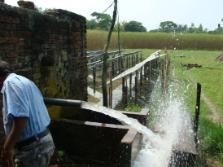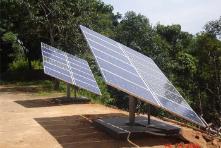Why Solar Water Pumping?
If you need to supply water beyond the reach of power lines, then solar power can solve the Problem. Photovoltaic powered pumps provide a welcome alternative to fuel-burning engines, windmills, and hand pumps. Thousands of solar pumps are working throughout the world. They produce best during sunny weather, when the need for water is greatest.
How it Works

Photovoltaic (PV) panels produce electricity from sunlight using silicon cells, with no moving
parts. They have been mass-produced since 1979. They are so reliable that mostmanufacturers give a 10-year warranty, and a life expectancy beyond 20 years. They work well in cold or hot weather. Solar water pumps are specially designed to utilize DC electric power from photovoltaic panels. They must work during low light conditions at reduced power, without stalling or overheating.
Livestock Watering: Cattle ranchers in the Americas, Australia and Southern Africa are
enthusiastic solar pump users. Their water sources are scattered over vast rangeland
where power lines are few, and costs of transport and maintenance are high. Some
ranchers use solar pumps to distribute water through several miles (over 5 km) of pipelines.
Others use portable systems, moving them from one water source to another.
Irrigation: Solar pumps are used on small farms, orchards and gardens. It is most economical to pump PV array-direct (without battery), store water in a tank, and distribute it by gravity flow. Where pressurizing is required, storage batteries stabilize the voltage for consistent flow and distribution, and may eliminate the need for a storage tank.
Domestic Water: Solar pumps are used for private homes, villages, medical clinics, etc. A water pump can be powered by its own PV array, or by a main system that powers lights and appliances. An elevated storage tank may be used, or a second pump called a booster pump can provide water pressure. Or, the main battery system can provide storage instead of a tank. Rain catchment can supplement solar pumping when sunshine is scarce. To design a system, it helps to view the whole picture and consider all the resources.
Careful Design Approach

When a generator or utility mains are present, we use a relatively large pump and turn it on only as needed. With solar pumping, we don’t have this luxury. Photovoltaic panels are expensive, so we must size our systems carefully. It is like fitting a suit of clothes; you need all the measurements.
|